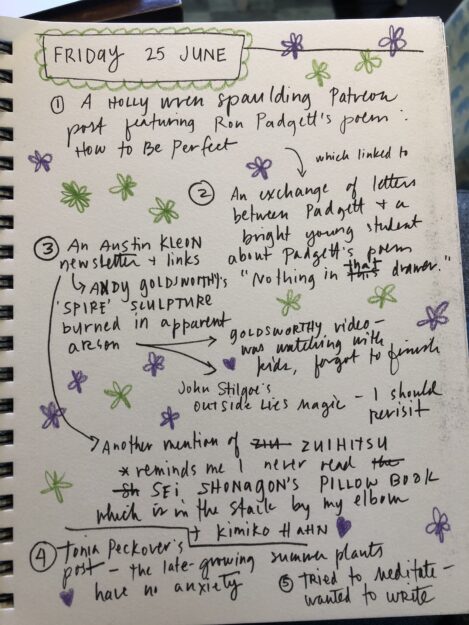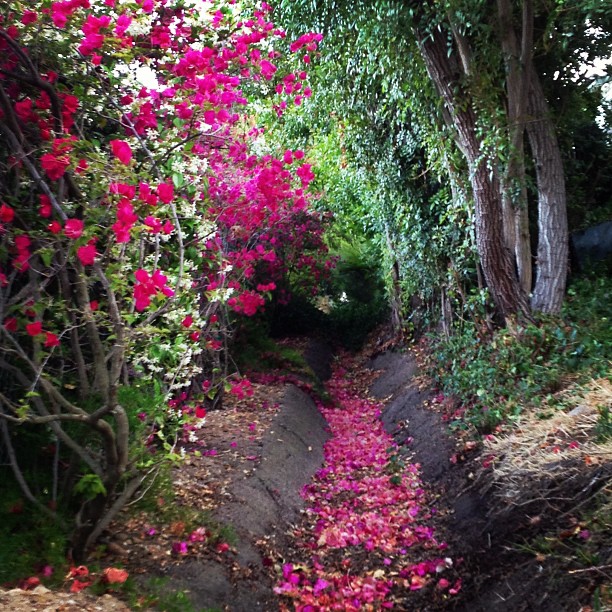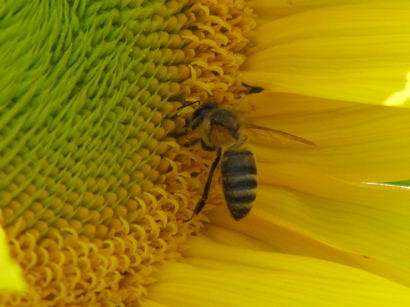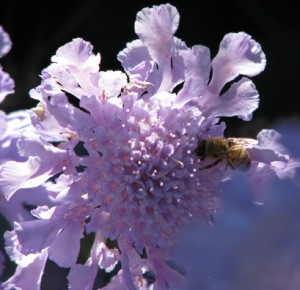![[Image: a mass of starry flowers, creamy pale yellow, against green leaves]](https://melissawiley.com/wp-content/uploads/2019/05/I-will-never-not-be-in-love-with-spring-500x625.jpg)
It’s been nearly a month since my last post here, and over a month since I shared any of my own photos on Instagram. This time, the silence was intentional, an awareness that I needed to sit quietly and read and learn, amplifying voices other than my own. I’m working through Mia Birdsong’s antiracism resource list, reading more slowly than is my usual gulping habit. I’m trying to listen more than I speak.
(Facebook friends will know I’ve not been totally quiet over there—that’s the space where I feel most compelled to speak out, for reasons that probably merit unpacking. That’s for another post, though.)
I’ve been wondering when I would come back to this space, and to Instagram, which is where I express myself in visual images—not planning for it, just allowing the tide to carry me back. I never feel entirely myself when I’m not blogging. Last year I read Austin Kleon’s Show Your Work and thought: aha, that’s it, that’s what I was doing for a solid decade on Bonny Glen—showing my work, thinking out loud, writing to discover what I know and what I think. Learning in public.
Of course, it was easier to “show my work” when the main part of my work was homeschooling young children. Thinking my way through various educational philosophies, curating resources, and chronicling our daily learning adventures—these were practices that felt fluid and natural. Inevitable, even. Once I made up my mind about how best to approach our home education experience, I found I had less to say—just as my feverish urge to discuss a book subsides after I finish reading it.
***
I wrote (a much longer version of) the above across two mornings. And now today I’ve written a new post, which I thought I was going to put on Patreon but (you’ll see me thinking through it below) decided to move over here, which means now I need to go through and reverse all the heres and theres of the first draft. And it’s getting late! Breakfast is nudging me. But I’m not ready to stop. If I include this morning’s efforts, this post will be monstrously long. Maybe that’s to be expected after a month away!
***
I’ve been driving myself a little bit crazy in the mornings. You’d think the quarantine would have seen me sinking deeper into the creative practice that nourished me all last year—the early rising, the yoga-stretching while water boiled for my cocoa, the fervent commitment to Poetry Before Screens, the writing of morning pages or what Holly Wren Spaulding calls “zero drafts” of poems, the heady feeling of having written, no matter what else the day brought. How gratifying to have the time and space for this practice; how satisfying to feel well begun each day. You’d think!
Instead, I’ve let my good habits slip, one by one. Standing in the kitchen reading Twitter while the water boils? Ah, there’s the whole thing dashed in one swoop. No stretching, no poetry, screens first. The most agitating kind of screen. One tiny choice each morning: which domino chain will I set off?
I resisted the Twitter urge today, the gnawing desire to see what happened in the night, in the East Coast morning while I slept (good thing, because the news of the Trump administration’s renewed efforts to cancel our healthcare would have utterly derailed any creative activity). It drains you, exercising willpower constantly. That’s why habits are so important; they remove the need to expend mental energy on constant choosing.
I worked hard to build good habits around creative practice. If I start my mornings reading—poems, essays, not news—I’ll want to write. Every time, simple as that. Ross Gay’s The Book of Delights, for example, sends me soaring and makes my pen twitch.
This morning I kept my rules, and here I am writing. I had a laughing revelation about myself a few minutes ago: I’d followed the steps of my creative practice faithfully, reading all the right things, and I’ve been trying (even, or especially, on the Twitter mornings) to do a tiny two-minute meditation to clear my mind for writing—just two minutes! With an aim to work up to five. This morning I couldn’t make it thirty seconds—and it hit me that what always happens, half a minute or a minute into silence and breathing, is that my mind starts writing. I wrench focus back to breath and two seconds later I’m scribbling another line in my head.
It was comical, suddenly, to realize that I’ve been trying to cultivate a habit that will help me write, and then I exasperatedly push away the writing that wants to interrupt the habit. It struck me as a bit like swatting away the action verb to focus on the helping verb. (And maybe that’s the point of meditation—sitting quietly with “I am” instead of leaping, scrawling, dashing.)
Laughing at myself shattered the silence and I gave in to the impulse to reach for my notebook. I wanted to write down the path my reading had taken before I tried to meditate.

—A Holly Wren Spaulding post featuring a Ron Padgett poem, “How to Be Perfect.”
—Linked in the post, an exchange of letters between Padgett and a bright young student about Padgett’s delightfully inscrutable poem “Nothing in That Drawer.”
—An Austin Kleon newsletter, which I can always trust to send me in good, writery directions. Such as:
• this article about the arson-suspected burning of Andy Goldsworthy’s Spire sculpture in the Presidio (reminding me, because of a long-ago Goldsworthy connection, of John Stilgoe’s Outside Lies Magic, which I should think about rereading);
• a mention of zuihitsu (re Kenko’s Essays in Idleness), which reminded me I meant to read Sei Shonagon’s Pillow Book, purchased months ago on a recommendation from Kimiko Hahn in her exquisite zuihitsu collection, The Narrow Road to the Interior
—Tonia Peckover’s new blog post, especially this:
In the garden this morning, I noticed the cool-weather crops have been lingering around longer than usual and the summer plants are still small and unsteady, different than other late Junes – but not surprising for this cool and rainy one we’ve just had. There is no sense of frustration there, no anxiety vibrating off the tomato leaves. I want to live by such confidence, content with the sun I am given, and the rain when it falls, taking what I can and growing. I admit I am not there yet.
I have notebooks full of these connection-lists, each entry dissolving into original writing, notes toward poems or posts. It strikes me that I used to do this kind of chronicling of the day’s rabbit trails here on the blog almost daily! Those collections of thought are invaluable to me now, and they’re much easier to revisit in my blog archives than in my heap of crammed notebooks.
I’m sure there’s a reason I needed to spend the past year writing by hand, but I’ve become frustrated with the aftermath: I can’t get to the particular note or draft I’m looking for without paging through half a dozen Leuchtturms. (Not to mention the expense. That paper is a dream to write on, but those purchases were a thing of the Before Times. My quarantine reality is: use what you have.)
I’m uneasily aware that one reason I keep dropping the blogging habit is because of my Patreon. I have the hardest time deciding where a post belongs. There, because it’s about creative practice? Here, where I’ve stashed fifteen years’ worth of booknotes? There, where I have a bit more privacy, which changes how I write? Here, where search engines can find me (meaning I’ll have an easier time, myself, finding references and quotes later)?
For better or for worse, today it’s going here.
I wrote that line on Patreon and then immediately decided, nope, wrong spot. So here it is, all of it. Way leading on to way.
This is me, showing my work.
Tags: andy goldsworthy, austin kleon, creative practice, holly wren spaulding, John Stilgoe, kimiko hahn, mia birdsong, Patreon, poetry before screens, ron padgett, ross gay, tonia peckover, zuihitsu

Image source: Wikimedia Commons
I’ve written about this book before:
 “Round Buildings, Square Buildings, and Buildings that Wiggle Like a Fish
“Round Buildings, Square Buildings, and Buildings that Wiggle Like a Fish by Philip M. Isaacson. Twelve years ago, this children’s book was my introduction to the study of architecture. I’ve never looked at buildings the same way since.
by Philip M. Isaacson. Twelve years ago, this children’s book was my introduction to the study of architecture. I’ve never looked at buildings the same way since.
“Isaacson takes the reader on a leisurely, respectful tour of buildings around the world: churches, houses, museums, lighthouses, all kinds of structures, from the humble to the magnificent. In simple, straightforward prose he discusses various architectural concepts such as the impact of building materials, the interplay of light and color, and the significance of roof shape. His stunning photographs turn even the roughest earthen hut into a work of art. His lyrical text helps us see in the pictures what we might otherwise have missed:
‘These buildings are part of the Shaker Village at Sabbathday, Maine. On an afternoon in late winter they are warm and creamy, but in December, shadows thrown at them make them look haunted. A building only a few yards away fades into the land on a hazy morning.'”
—Originally posted March 11, 2006: “The Poetry of Walls.”
Round Buildings, Square Buildings was edited by my first boss in publishing, the great Stephanie Spinner. It was near completion by the time I came on board; I don’t think I did much more than look over galleys and jacket copy, and probably put through the request for Mr. Isaacson’s author copies. It’s one of those books I sat at my desk reading, unable to believe my good fortune: This is my job now; I’m getting paid to read.

Before Round Buildings I hadn’t done much real seeing of architecture. There were buildings I loved: the sandstone administration building (formerly a convent) of my first college, Loretto Heights, with its red tower soft-edged against a blue sky, and inside, a gorgeous mosaic floor—tiny tiles set into place by wagon-training nuns, so the story went. But even there, I was drawn more to story than to form. Most of the buildings that captured my imagination, pre-Isaacson, lived in books: Green Gables, the House o’ Dreams, Jane’s Lantern Hill house with its “lashings of magic.” The Muskoka cabin. (No one does houses better than Montgomery.) Plumfield. Juniper’s cottage. Miss Suzy’s tree-house with its acorn cups. Vicky Austin’s grandfather’s house-in-a-converted-stable with the stalls full of books. A great many English houses in a great many English novels.
But most of the time, my eye was drawn more to nature than to man’s edifices. I had next to no vocabulary for understanding architecture. Isaacson changed that in a paragraph with his description of the creamy walls of the Taj Mahal changing colors as the sun moved across them—the very passage I read with Beanie and Rose this morning. He writes about harmony and you find yourself looking for it everywhere you go. He made me see my world differently—just as John Stilgoe’s Outside Lies Magic changed how I looked at just about everything else: power lines, rain gutters, a sculpture garden, the line at the DMV. The way Betty Edwards’s Drawing on the Right Side of the Brain changed the way I see faces.

Clicking through these old posts, I see I’ve made a connection between these three books before. They’re transformative, all three.
Funny also to see in the old Stilgoe post I linked above, “Way Leads on to Way,” that I’d been reading Fifty Famous Stories Retold* to Beanie that year—in March, 2008, when she was seven years old. And now here’s Rilla seven, and I’m reading it to her. (Today’s tale: Androclus and the Lion. It drew cheers, and a narration with gusto. Because LION.) I have to laugh: way doesn’t just lead on to way; sometimes it leads right back full circle. I didn’t choose Round Buildings for the older girls and Fifty Famous Stories for the seven-year-old at the same time—again—on purpose; I guess it’s just that I’ve been doing this long enough now that I know what works for us, and these things have worked time and again. It did strike me this morning, reading the Isaacson, that the Stilgoe might be a satisfying read for Jane and Rose right about now.
*free on Kindle
**Also wonderful: Isaacson’s sequel, A Short Walk Around the Pyramids and Through the World of Art

As you know, I’ve had bees on my mind for weeks. I keep talking about Fruitless Fall: The Collapse of the Honey Bee and the Coming Agricultural Crisis, the book about bee colony collapse written by my former grad-school classmate, Rowan Jacobsen.
How much have you read about bee colony collapse?
I knew the honeybee’s numbers were declining. I remember hearing the wacky cell phone theory several years back, and that was laughed out of the news, and since then I’ve just heard ominous mutterings now and then about the bees disappearing and nobody knows why.
But I didn’t know the half of it.
I didn’t know, for example, that nowadays U.S. beekeepers earn most of their income—far more than they earn selling honey—trucking their hives around the country to pollinate crops. Somehow this gobsmacks me. We are dependent on migrant worker bees for the produce we grow in this country.


I definitely didn’t know that in the winter of 2006/2007, huge numbers of these hives began to die, and no one is sure exactly why. There are theories, which is a lot of what Rowan’s book is about: an in-depth and thoughtful exploration of what could possibly be causing the collapse of our bee colonies.
As I said above, when I heard about “the disappearance of the honeybee” I thought it meant declining numbers. Pesticides, I assumed (and indeed that seems to be a major factor). What I didn’t get was that bees literally disappeared. The hives died because the forager bees flew out and didn’t fly back home. There are diseases and pests that kill bees, and you find dead bees in and around the hive. (That’s happening too, in horrifying numbers.) But in other cases, the bees just up and disappeared. One possible explanation, Rowan learned, is a kind of disorientation and memory loss known to be a symptom of neurological damage caused by certain pesticides. It’s possible the bees are suffering from something like bee Alzheimer’s due to exposure to toxins meant to kill other insects. They fly off to work and can’t find their way back home. And in other hives, there are bees carrying every bee disease, fungus, and pest known to afflict the honeybee world—all at once. It’s as if their immune systems have been decimated (possible cause: the catastrophic wave of varroa mite infestation that arrived in this country a few years back and is a terrible scourge in many parts of the world right now), leaving them susceptible to other illnesses.
And it isn’t just the honeybees: we know a lot about the decline in their numbers because they are domesticated bees, owned by devoted beekeepers who know exactly how many hives they have lost to varroa and bee colony collapse. No one has good numbers on all the other pollinating insects out there, except it seems clear honeybees aren’t the only pollinators in decline. Did you know vanilla beans are hand-pollinated by humans? The insect pollinator has been wiped out.
 Obviously Fruitless Fall made a big impact on me. Shook me up; Jane too. The funny thing is, at the very same time that it was scaring the pants off me (a world short on pollinators is a scary, scary concept), it was filling me with wonder and delight. I know that sounds impossible. It’s the way Rowan looks so closely, with humor, warmth, and affection, at this ordinary (extraordinary!) creature, the honeybee. It reminded me of the John Stilgoe book I kept raving about last year, Outside Lies Magic. Remember that one? What Stilgoe did for me with power lines and telephone poles, Rowan Jacobsen did for me with bees and honey and even figs. The early chapters describing life in a beehive and the life cycle of the bee were so engaging that I read them aloud to 8-year-old Beanie, who was captivated. Jane (almost 14) has read the book at least three times now. She begged me to order Rowan’s book on chocolate—along with our very own copy of Fruitless Fall. Which is a good thing, because I find myself wanting to thrust the book at everyone I talk to. It’s that kind of book.
Obviously Fruitless Fall made a big impact on me. Shook me up; Jane too. The funny thing is, at the very same time that it was scaring the pants off me (a world short on pollinators is a scary, scary concept), it was filling me with wonder and delight. I know that sounds impossible. It’s the way Rowan looks so closely, with humor, warmth, and affection, at this ordinary (extraordinary!) creature, the honeybee. It reminded me of the John Stilgoe book I kept raving about last year, Outside Lies Magic. Remember that one? What Stilgoe did for me with power lines and telephone poles, Rowan Jacobsen did for me with bees and honey and even figs. The early chapters describing life in a beehive and the life cycle of the bee were so engaging that I read them aloud to 8-year-old Beanie, who was captivated. Jane (almost 14) has read the book at least three times now. She begged me to order Rowan’s book on chocolate—along with our very own copy of Fruitless Fall. Which is a good thing, because I find myself wanting to thrust the book at everyone I talk to. It’s that kind of book.
![[Image: a mass of starry flowers, creamy pale yellow, against green leaves]](https://melissawiley.com/wp-content/uploads/2019/05/I-will-never-not-be-in-love-with-spring-500x625.jpg)



 “
“



 Obviously Fruitless Fall made a big impact on me. Shook me up; Jane too. The funny thing is, at the very same time that it was scaring the pants off me (a world short on pollinators is a scary, scary concept), it was filling me with wonder and delight. I know that sounds impossible. It’s the way Rowan looks so closely, with humor, warmth, and affection, at this ordinary (extraordinary!) creature, the honeybee. It reminded me of the John Stilgoe book I kept raving about last year,
Obviously Fruitless Fall made a big impact on me. Shook me up; Jane too. The funny thing is, at the very same time that it was scaring the pants off me (a world short on pollinators is a scary, scary concept), it was filling me with wonder and delight. I know that sounds impossible. It’s the way Rowan looks so closely, with humor, warmth, and affection, at this ordinary (extraordinary!) creature, the honeybee. It reminded me of the John Stilgoe book I kept raving about last year,